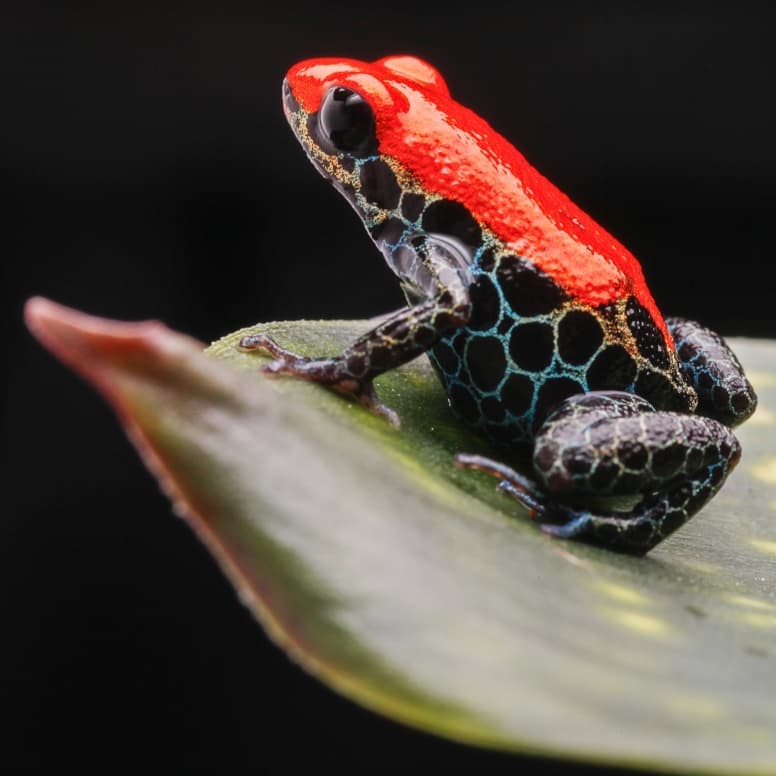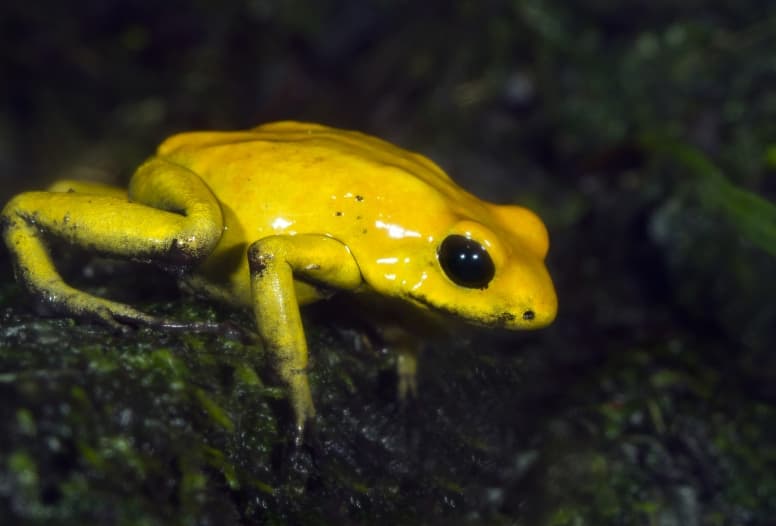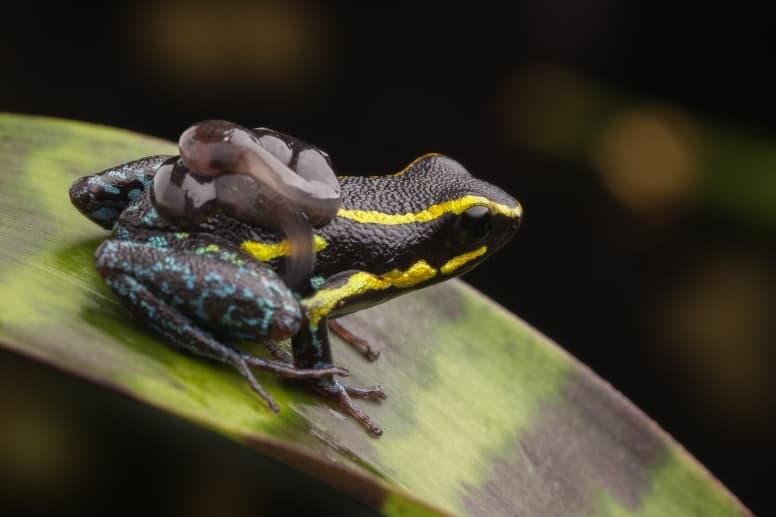Poison Dart Frog Profile
This is a group of frogs from the family Dendrobatidae, that are well known their bright colours and highly toxic nature.
Their name comes from the fact that indigenous Amazonian groups use the poison from several species of the frog to make poison darts.

Poison Dart Frog Facts Overview
| Habitat: | Humid tropic forests |
| Location: | Central and South America |
| Lifespan: | Up to 15 years |
| Size: | 1.5cm to 6cm |
| Weight: | Around 28grams |
| Color: | Some are bright colours (yellow, green, gold etc) while others are more dull (green, brown, black) |
| Diet: | Ants, beetles, flies, mites, centipedes |
| Predators: | Fire-bellied snake (Leimadophis epinephelus) |
| Top Speed: | Around 16kph |
| No. of Species: |
More than 170 species |
| Conservation Status: |
Many endangered |
There are over 170 species of poison dart frogs, but not all are poisonous. Many are colourful to show of how dangerously toxic they are, while others are plain and completely non-toxic.
They are found in tropical regions of Central and South America, where they inhabit humid topical forests like the Amazon.
The majority live on the forest floor, however some like to live up in the canopy. As amphibians, they need to be near a source of water.
They can live up to 15 years in the wild, and longer in captivity.
Interesting Poison Dart Frog Facts
1. Indigenous peoples used their toxins to make darts.
Their toxins were placed in the tips of blow darts, giving them their name. Indigenous people use just 4 species of poison dart frog, which have some of the highest toxicity of all dart frogs.

2. There are over 170 species of poison dart frog.
There are a huge variety of poison dart frogs, and not all of them are poisonous.
3. They are poisonous, not venomous.
This means that they do not inject their toxins into others, like snakes, they instead have to be consumed or licked.
4. Their toxins are secreted from their skin.
They are stored in glands under the skin, with the toxin being secreted through pores. When stressed, a frog may secrete large amounts of toxin all at once.

5. Their toxins are for self-defence, not hunting.
They never use these toxins to attack or for hunting, they are only for self-defence. When a predator consumes them, they either die or are extremely ill. Overtime, animals learn not to consume them.
6. Poison dart frogs are aposematic.
This is the scientific term given to animals that signify their toxicity with bright colours. Predators see their bright colours and know they are not safe to eat. 1
7. The most colourful are the most toxic.
The degree of toxicity generally coincides with how bright they are. The most toxic species have very bright colours, while those that aren’t toxic are dull.

8. Their toxins likely come from their diets.
While scientists aren’t sure, it seems that the toxins the frogs produce come from a diet high in toxin-containing animals, such as ants or centipedes. This seems likely as those with the highest toxicity, consume the most ants. As well, pet poison dart frogs that are kept as pets lose their toxicity as they no longer have access to their normal diet. 2
9. The golden poison dart frog is the most toxic.
The toxin from this poison dart frog can stop the human heart almost instantaneously.
One frog has an average of one milligram of poison, which is enough to kill up to 20 people, or two African bull elephants.

10. One snake has evolved resistance to the toxins.
The Fire-bellied snake (Leimadophis epinephelus), has evolved to have immunity to the highly toxic golden poison dart frog (Phyllobates terribilis), making them the frogs’ only predator.
11. The toxins have medical uses.
Research has shown that toxins from these frogs have various medical uses. Recent research has found a compound in the toxins that is a painkiller stronger than morphine, but with none of the side effects. 3
12. Almost all are diurnal.
This means that they are active during the day. This is unusual as most amphibians are usually active at night. This is part of the reason why they have such bright colours and high toxicity as it allows them to repel predators that are active during daylight.
13. Poison dart frogs often lay their eggs on plants or roots.
They will lay their eggs in moist places, such as on plants higher up or in the leaf litter of the forest floor.
14. Many species carry the hatched tadpoles on their backs.
Poison dart frog mothers will often hang around until the eggs have hatched and then carry the tadpoles to a near water source. Mothers may then continue to care for the tadpoles by bringing them unfertilised eggs to eat.

15. Some mothers carry individual tadpoles to individual pools.
She’ll take each tadpole to its own little pool, then bring each of them food. For example, the strawberry poison dart frog carries individual tadpoles up to almost the top of the canopy where she places it in the water that gathers in the leaves of bromeliads.
16. Mother poison dart frogs supply their tadpoles with poison.
A study found that mother frogs will feed their tadpoles unfertilised eggs which are high in toxins. This helps the tadpoles become poisonous. 4
17. Both males and females fight over territory.
Males will fight over the best spots to do their mating calls from, while females fight over the best nests.
18. They are popular pets, driving an illegal trade.
Due to their bright colours and small size, they have become popular exotic pets internationally. However, this popularity is driving an illegal trade which is threatening wild populations of endangered species.

19. Sadly, they are threatened.
Many poison dart frogs now appear on the endangered species list, as deforestation and human infrastructure projects continue to encroach on their natural habitat.
Poison Dart Frog Fact-File Summary
Scientific Classification
| Kingdom: | Animalia |
| Phylum: | Chordata |
| Class: | Amphibia |
| Order: | Anura |
| Family: | Dendrobatidae |
Fact Sources & References
- Prince RJ, Sine SM. Epibatidine activates muscle acetylcholine receptors with unique site selectivity. Biophys J. 1998;75(4):1817-1827. doi:10.1016/S0006-3495(98)77623-4
- Caldwell JP. The evolution of myrmecophagy and its correlates in poison frogs (Family Dendrobatidae). J Zool. 1996;240(1):75-101. doi:10.1111/j.1469-7998.1996.tb05487.
- Stynoski JL, Torres-Mendoza Y, Sasa-Marin M, Saporito RA. Evidence of maternal provisioning of alkaloid-based chemical defenses in the strawberry poison frog Oophaga pumilio. Ecology. 2014;95(3):587-593. doi:10.1890/13-0927.1
- Steffens G. How to undermine the black market in poison dart frogs. National Geographic. Published 2018. Accessed March 3, 2021.
